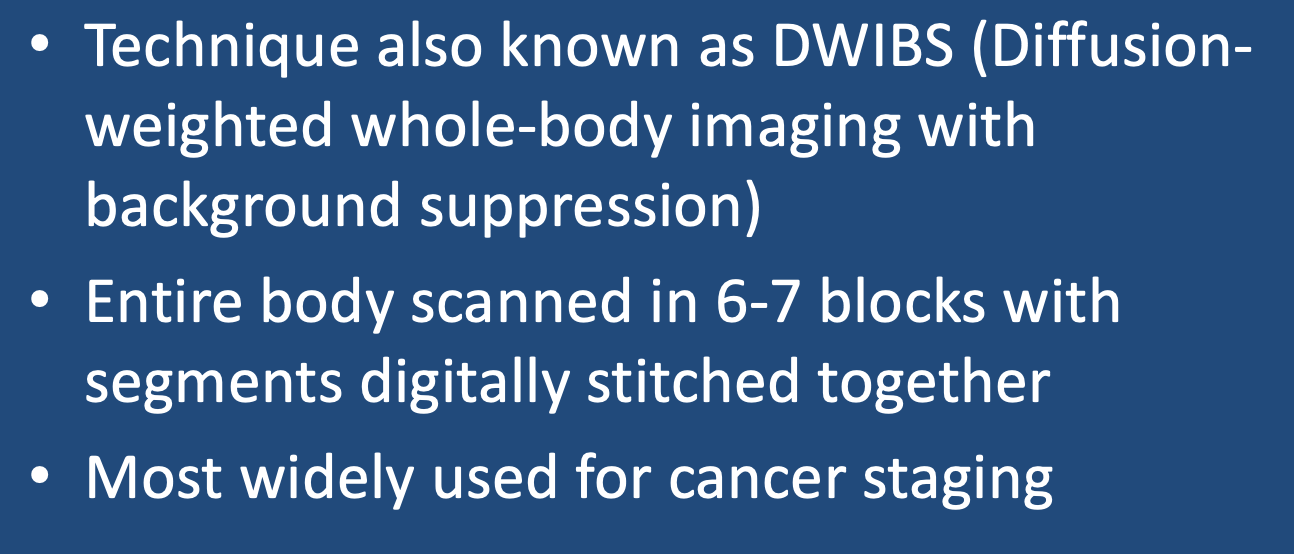|
For many years DW imaging of the body under free breathing conditions was considered impossible because it was thought that cardiac and respiratory motion would lead to irretrievable loss of diffusion-weighted information. In 2004 Takahara et al. overcame these limitations, developing a technique they named diffusion-weighted whole-body imaging with background body signal suppression (DWIBS), an acronym still used by Philips for their product sequence. Equivalent whole-body DW sequences are now available from other vendors: GE (enhanced(e)DWI), Siemens (REVEAL), Hitachi (body DWI), and Canon (Body Vision).
The conceptual break-through that made whole-body DWI feasible was the recognition that even though organs of the abdomen and chest move during image acquisition, they do so "coherently". Their physical displacements are cyclic and while this motion produces some spatial blurring it does not significantly affect the magnitude of the DW signal. As currently implemented, whole-body is more reliably performed at 1.5T because of increased susceptibility artifacts at 3.0T. Moderately strong diffusion-sensitizing gradients are used (b-values on the order of 1000 s/mm²), preceded by a plus an inversion pulse (SPAIR or STIR) for fat suppression. Blocks of approximately 40-50 axial images 4-5-mm-thick are acquired using parallel imaging and echo-planar readout, with imaging times in the range of 6-7 min per station. Depending on patient size a "whole-body" DWI survey from the neck through the pelvis can be acquired in 45 minutes or less. A true whole body scan from head to toe may require 6-7 blocks and take somewhat longer. The blocks are digitally stitched together and typically displayed in an inverted mode that resembles PET-CT. Lymphoma, prostate cancer, and small cell carcinoma have been the most widely studied. Because of artifacts, conventional MR images must still be obtained for confirmation of certain DWI lesions. |
Advanced Discussion (show/hide)»
The major vendors are certainly pushing this product. The technique certainly has a visual appeal, making one believe that it can almost replace PET-CT for the staging of lymphoma and other cancers.
The interpretive problems surrounding whole body DWI, however, are not trivial. Many indeterminate and questionable lesions are identified that may need to be resolved by other conventional methods. The technique works best for a few cancers (like lymphoma and small-cell tumors) that significantly restrict diffusion, but has been applied with success to others (like breast and lung). Whole body DWI has also been used to display other systemic disorders affecting bones and nerves. We will just have to wait and see to what extent WB can replace or complement PET-CT for cancer staging.
Godinho MV, de Oliveira RV, Canella C, et al. Initial experience with whole-body diffusion-weighted imaging in oncological and non-oncological patients. MAGNETOM Flash 2013; 2:94-102.
Koh D-M, Blackledge M, Padhani AR, et al. Whole-body diffusion-weighted MRI: tips, tricks, and pitfalls. AJR Am J Roentgenol 2012; 199:252-262.
Kwee TC. New techniques for staging malignant lymphoma. Utrecht, 2011, pp. 67-111.
Mosavi F, Ullenhag G, Ahlström K. Whole-body MRI including diffusion-weighted imaging compared to CT for staging of malignant melanoma. Ups J Med Sci 2013; 117:91-97.
Takahara T, Imai Y, Yamashita T, et al. Diffusion weighted whole body imaging with background body signal suppression (DWIBS): technical improvement using freet using free breathing, STIR and high resolution 3D display. Radiat Med 2004;22:275-282

